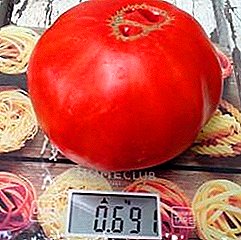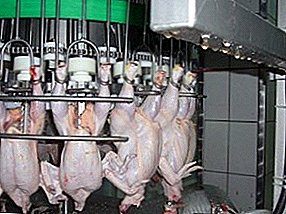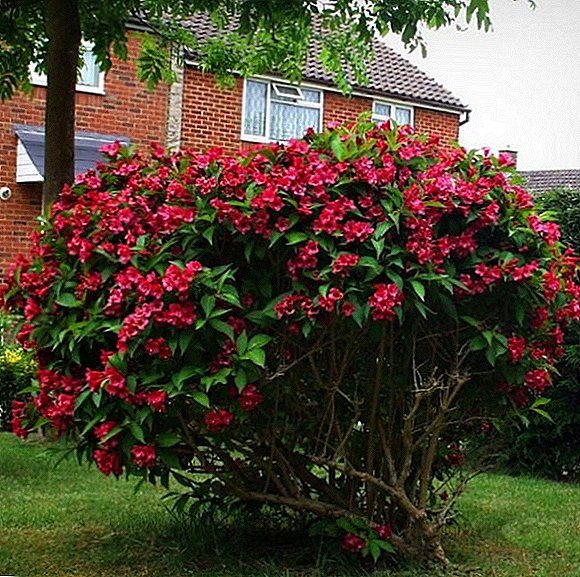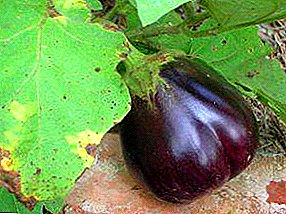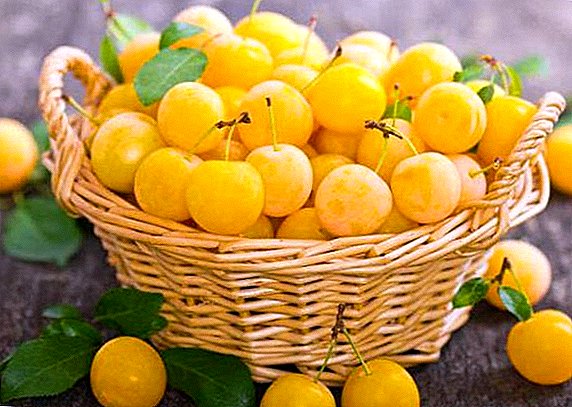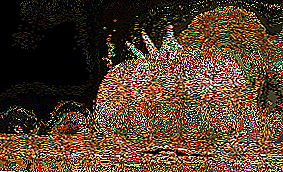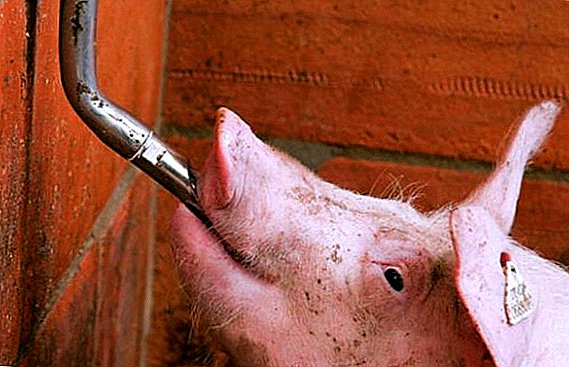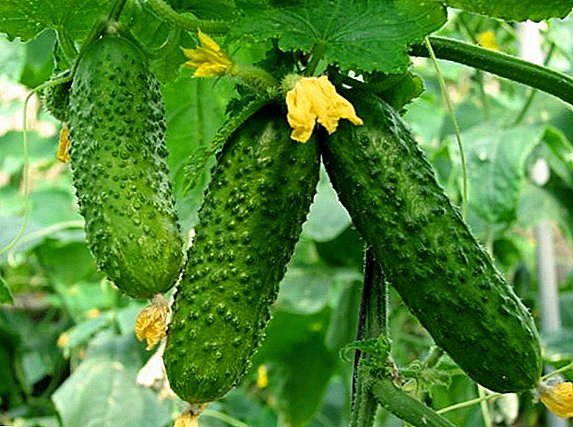 Every year, farmers and gardeners complain cucumber pests, which both reduce the safety of the crop, and completely destroy it. Most often, the parasite manages to inflict enough damage before it is noticed and will begin to corrode. It is necessary to react in a timely manner to various insects, bugs and larvae, which imperceptibly for you can badly spoil the crop or infect the plant with diseases. It will be about pests of cucumbers, which most often give trouble to farmers and gardeners.
Every year, farmers and gardeners complain cucumber pests, which both reduce the safety of the crop, and completely destroy it. Most often, the parasite manages to inflict enough damage before it is noticed and will begin to corrode. It is necessary to react in a timely manner to various insects, bugs and larvae, which imperceptibly for you can badly spoil the crop or infect the plant with diseases. It will be about pests of cucumbers, which most often give trouble to farmers and gardeners.
Gall nematodes
 They are microscopic worms that belong to the genus of roundworms. The parasite has a length of up to 2 mm and is painted in white or pearl color. The root nematode affects the plant in the warm season with moderate humidity (+ 25-30 ° C and humidity of 60-65%). Infection occurs through the soil where the parasite lives. Also, worms can be brought along with a purchased plant, flowers or organic fertilizers.
They are microscopic worms that belong to the genus of roundworms. The parasite has a length of up to 2 mm and is painted in white or pearl color. The root nematode affects the plant in the warm season with moderate humidity (+ 25-30 ° C and humidity of 60-65%). Infection occurs through the soil where the parasite lives. Also, worms can be brought along with a purchased plant, flowers or organic fertilizers.
Signs of cucumber damage:
- growth retarded;
- shoots and leaves curl;
- very few thin roots are formed;
- swelling on the roots;
The most accurate method for testing nematodes is the biological method. Cucumber seeds are sown in open ground. 18 days after germination, the plants dig out and check the roots, where the affected areas and the worms themselves will be visible.
The pest interferes with the metabolism in the plant. The cucumber bush lacks moisture, loses nutrients and produces a poor harvest. The disease can not kill the plant, but it greatly reduces its productivity.
 Treat diseased cucumbers need chemicals. For etching microscopic worms use drugs "Mercapthos", "Phosphamide" or "Ruscamine". Processing should be carried out 3-4 times.
Treat diseased cucumbers need chemicals. For etching microscopic worms use drugs "Mercapthos", "Phosphamide" or "Ruscamine". Processing should be carried out 3-4 times.
Heat treatment of roots is effective. For this, the plant is dug out, and its roots are dipped into water with a temperature of 50-55 ° C for 10-15 minutes. Since the nematode dies at a temperature of + 40 ° C, this treatment is very effective against both adults and larvae.
Preventive actions:
- Processing of purchased plants with 0.5% solution of "Parathion". The substance is diluted in water, then the cucumber roots are immersed in the liquid for 15 minutes.
- Heat treatment of the soil before planting. Within 2 hours the soil warms up at a temperature of 100˚С.
- Ultraviolet irradiation. The nematode is killed by ultraviolet radiation, which can irradiate the roots of the plant without harm to the latter.
- Weed control.
- Incorporation into the soil of cow dung.
Gourd Aphid
 It is a sucking insect from the order Homoptera. The insect can have a different color: from yellow to dark green. The size of pests does not exceed 2 mm. The larvae of gourd aphids hibernate on weeds or leaves. Sometimes they can survive the winter in an anthill. Infection of cucumbers occurs in July and August. Most often, ants that use insects in the form of "domestic animals" carry the aphids to the cucumber bushes.
It is a sucking insect from the order Homoptera. The insect can have a different color: from yellow to dark green. The size of pests does not exceed 2 mm. The larvae of gourd aphids hibernate on weeds or leaves. Sometimes they can survive the winter in an anthill. Infection of cucumbers occurs in July and August. Most often, ants that use insects in the form of "domestic animals" carry the aphids to the cucumber bushes.
The danger of infection with aphids is not only that it sucks the sap from the plant, releases poison in the process of vital activity, thereby damaging the leaves and shoots. And also that besides aphid, ants settle on your cucumbers, which also feed on the sap of the plant. In addition to direct harm, aphid can be a carrier of viruses and diseases.
Signs of parasitizing melon aphid on cucumbers:
- puckering leaves;
- fall of flowers and ovaries;
- drying of leaves;
- inhibited growth of cucumbers.
There are many methods of fighting with aphids. Most gardeners are accustomed to counting aphids as not dangerous, and either simply do not pay attention to this pest or use folk remedies and simple mechanical cleaning of the plant. It is precisely because of a frivolous attitude to the aphids that it can flood the entire plot and lead to a loss of the harvest.
Traditional methods offer the following treatment recipes:
- Spraying infusion of red bitter pepper. To prepare an infusion for 10 liters of water, 30 g of freshly ground pepper and 200 g of tobacco dust are taken. After mixing, let stand for 24 hours, strain, add 1 tbsp to the solution. l liquid soap and 150 grams of ash. Spray the aboveground part of the plant with a flow rate of 1-1.5 liters per square meter. m
- For the next solution, we take 200 g of ash and 50 g of soap per 10 liters of water. We insist, filter and process cucumbers from a spray bottle.
- Garlic infusion. On 1 liter of water we take 200 g of crushed garlic cloves and insist 4 days. Then the infusion is diluted in water at the rate of 25-30 g per 10 l and sprayed with bushes.
- Broth from celandine. We take 400 g of green leaves of a plant on 1 l of water, insist for 24 hours, and then boil for 30 minutes. The resulting solution does not need to be diluted.
 Sometimes you do not want to turn to the folk methods because of the waste of time for the preparation of decoctions or dubious utility. In this case, you can use chemicals, namely: Malathion, Commander, Spark. To less toxic for human drugs include "Aktophyt" and "Fitoverm".
Sometimes you do not want to turn to the folk methods because of the waste of time for the preparation of decoctions or dubious utility. In this case, you can use chemicals, namely: Malathion, Commander, Spark. To less toxic for human drugs include "Aktophyt" and "Fitoverm".
In addition to insecticides and popular methods, you can also use agrotechnological control measures. For a start, you need time to destroy the weeds and remove the rotten remnants of plants. A good option is planting plants that scare away aphids. (garlic, onion, fennel, mint, mustard, lavender). It is also worth far away to plant plants that their smell attract aphids (beans, petunia, viburnum, linden).
Many insects feed on aphids. As you know, ladybugs can eat aphids in colonies. However, if you are counting on the help of "live" pest control, the use of insecticides is unacceptable.
White fly
 Small butterfly, which have a length of 3 mm and white color. Both the insect itself and its larvae are harmful to the plant. The butterfly appears in the summer when it is very warm and there is a lot of rain. The combination of heat and high humidity are the best conditions for an insect. Whiteflies overwinter in greenhouses and covered greenhouses, where there is very poor ventilation and high air humidity.
Small butterfly, which have a length of 3 mm and white color. Both the insect itself and its larvae are harmful to the plant. The butterfly appears in the summer when it is very warm and there is a lot of rain. The combination of heat and high humidity are the best conditions for an insect. Whiteflies overwinter in greenhouses and covered greenhouses, where there is very poor ventilation and high air humidity.
The whitefly is dangerous because both the larvae and the adults will be feeding on your cucumbers at the same time. The insect and its larvae suck up the sap of the plant, disrupting the supply of nutrients and slowing the growth of cucumbers. The butterfly's feces erode the leaves, after which they turn black and dry. Pests of cucumber can be carriers of infectious diseases and fungi.
Important! Preparations for the destruction of adults and larvae are radically different, so pay attention to this when buying chemicals.
Finding the whitefly is easy. When inspecting the bush, you will clearly see a small midge that resembles a smaller copy of the moth.
When cucumber is affected by the whitefly, the following occurs:
- the plant is stunted;
- leaves turn yellow and curl;
- a sticky glistening patina appeared on the leaves;
- small scales are visible on the reverse side of the leaf.
To combat the pest created a huge amount of drugs. In addition to chemical methods, a small "mole" can be derived and folk remedies.
To expel the butterfly from the garden, use the following decoctions and infusions:
- Rubbed 3 tbsp. l onions or garlic and add to a glass of hot water. We insist 12 hours in coolness, filter and sprinkle cucumbers for a week. If we consider the proportion of 1 tbsp. l onions per 100 ml of water, then you will be able to prepare more solution for processing the entire area with cucumbers.
- Soap solution. We take soap and dissolve it in water in the ratio of 1 to 6. The solution is mixed to obtain a foam, which is applied with a sponge to the plant. This method is more suitable for small areas or greenhouses.
- Garlic infusion. 60 grams of minced garlic are taken per 10 liters of water. The solution is infused for 24 hours. It is necessary to process cucumbers once a week until the insect disappears.
- Tobacco infusion. We buy a pack of cigarettes like "Prima", we take out tobacco, we grind and we fill in 1 l of boiled water. It is necessary to insist 5 days in a dark place, then strain and sprinkle cucumbers every 2-3 days.
 If you want to quickly and efficiently eradicate an insect, then seek help from insecticides. The most popular drugs in the domestic market: Aktara, Konfidor, Akarin, Iskra, Fitoverm, Aktellik, Mospilan and others. Do not exceed the dose of drugs: think about how you then eat these fruits in food.
If you want to quickly and efficiently eradicate an insect, then seek help from insecticides. The most popular drugs in the domestic market: Aktara, Konfidor, Akarin, Iskra, Fitoverm, Aktellik, Mospilan and others. Do not exceed the dose of drugs: think about how you then eat these fruits in food.
If you keep cucumbers in a greenhouse and can affect the microclimate in a covered room, then affect the pest by lowering the temperature to + 10˚С and lowering the humidity to 80%. Such a decrease in temperature the pest will not stand and leave your bushes alone.
The option for indoor is yellow stickies. The insect loves yellow color and flies on it. After sticking to the surface of the ribbon, the whitefly will not be able to escape and will die.
Spider mite
 Known pest as vegetables and fruits, and indoor plants and shrubs. It is a small, up to 1 mm, spider mite, it feeds on plant sap. Mite gets on the plant from the soil, is carried by wind, water, on clothing, attached to the tools. Thus, it is impossible to completely protect cucumbers from tick infestation even in greenhouse conditions.
Known pest as vegetables and fruits, and indoor plants and shrubs. It is a small, up to 1 mm, spider mite, it feeds on plant sap. Mite gets on the plant from the soil, is carried by wind, water, on clothing, attached to the tools. Thus, it is impossible to completely protect cucumbers from tick infestation even in greenhouse conditions.
Mite likes dry air and low air humidity. However, there is a false spider mite that loves high humidity.
At first glance it may seem that a microscopic mite does not cause significant harm, however, if there are more than a thousand of such mites on one bush, the plant will start to ache and dry.
One can recognize the activity of spider mites by small white dots on the plant, as well as by a transparent web that envelops the leaves with “torn” mites. Ticks entangle the web with stems and fruits, covering the entire plant with microscopic threads.
Did you know? Spider mites live everywhere except in Antarctica!
In the world there are more than 950 species of spider mites, and every year more new and effective drugs are released to destroy the arachnoid parasite. The fight against spider mites involves the use of folk, chemical and biological methods of treatment.
To begin with, let's test the "grandfather's" methods of fighting the parasite:
- Tincture of garlic. Peel and chop 2 medium heads of garlic, pour a liter of water and insist 5 days. When the mixture is infused, dilute it with 1 to 1 with water and spray the plant.
- Tincture on the onion peel. For 10 liters of water, we take 200 g of husk and leave for about 5 days. When the "medicine" is infused, we filter and spray cucumber bushes. In this case, it is not necessary to dilute the tincture with water.
Some drugs are suitable for the destruction of several parasites. Thus, after processing these insecticides you can clean the cucumber bushes from several pests.
 In addition to chemistry and folk methods, there is another very good and safe option for the destruction of the tick. To do this, you need to acquire the natural biological enemies of the spider mite - phytoseiulus and Amblyseius, which do not cause harm to humans or plants. However, this method is more suitable for greenhouses and greenhouses, as useful mites can cover a small square planting.
In addition to chemistry and folk methods, there is another very good and safe option for the destruction of the tick. To do this, you need to acquire the natural biological enemies of the spider mite - phytoseiulus and Amblyseius, which do not cause harm to humans or plants. However, this method is more suitable for greenhouses and greenhouses, as useful mites can cover a small square planting.
It is important to carry out prophylaxis in order not to waste time on the treatment of cucumber. Spray the plant to make the conditions unsuitable for the mite. In this case, it is the above-ground part that is irrigated. Do not forget to properly care for the bushes and regularly feed them. A weakened plant is a tasty morsel for pests and diseases.
Medvedki
 If the parasite settled on the site, then he sometimes manages to destroy a huge number of plants, and therefore is one of the most dangerous pests of cucumber. Medvedka belongs to the family of large burrowing insects, has a length of up to 8 cm and a dark brown color.
If the parasite settled on the site, then he sometimes manages to destroy a huge number of plants, and therefore is one of the most dangerous pests of cucumber. Medvedka belongs to the family of large burrowing insects, has a length of up to 8 cm and a dark brown color.
Medvedka lives in areas with warm climates. The pest enters the garden through the soil. You can bring the soil from another site, and there will already be eggs or small larvae of the parasite in it. He can fly with his own forces from neighboring gardens. The ideal environment for a bear is a light fertile soil that is sufficiently moist.
Important! Medvedka lives in humus (uses it as a nest for his offspring), which is introduced in the form of fertilizer.
Understand that Medvedka appeared on the site as follows:
- very poor seedlings;
- Planted seedlings dry and fall;
- in the soil are visible passages of small diameter.
You can get rid of a medvedka both by folk methods and with the help of chemistry.
Several popular recipes from the pest:
- Soapy water. At 10 liters of water dissolve ½ piece of soap and 1 tbsp. l powder. The solution is poured into the hole of the bear. The parasite will either die or crawl to the surface, where you can finish it.
- Plastic cups. The seedling is placed in a plastic cup with a cropped bottom. Medvedka can not eat plastic, and therefore, just go around this obstacle.
- Water trap. We collect some water in a half-liter jar and bury it in the ground so that the neck is at ground level. Medvedok attracts dampness, and they fall into the trap.
Important! Spraying the above-ground body of cucumbers with any folk remedies will have no effect, since the pest lives and eats in the soil.
 Folk methods will not help destroy the medvedka on a large area, so turn to chemistry. The most popular profile drugs: Medvetoks, Thunder, Basdin, Perstige and Aktara. Used drugs strictly according to the instructions.
Folk methods will not help destroy the medvedka on a large area, so turn to chemistry. The most popular profile drugs: Medvetoks, Thunder, Basdin, Perstige and Aktara. Used drugs strictly according to the instructions.
There is a biological treatment option. To do this, use drugs "Nemabakt" and "Bowerin", which consist of predatory bacteria and fungi. These bacteria destroy the eggs of larvae and adults (the fungus grows through the body of the victim). The drug is very effective, since one package is enough for 100 squares.
There are preventive measures from Medvedka, but they are not suitable for all gardeners. We'll have to abandon the introduction of humus into the ground. Garlic and cilantro scares the pest, so the plants are planted around the perimeter of the site. It is possible to carry out mulching, which will reduce the temperature of the soil and impede the advancement of the parasite in the soil.
Ants
 Many gardeners and gardeners are surprised that ants are pests of plants. Since these insects inhabit any area, it is important to figure out how to get rid of ants on cucumbers, and what damage they cause to the plant. Ants belong to the insect family, and there are about 14 thousand species, of which about 300 inhabit the territory of the CIS.
Many gardeners and gardeners are surprised that ants are pests of plants. Since these insects inhabit any area, it is important to figure out how to get rid of ants on cucumbers, and what damage they cause to the plant. Ants belong to the insect family, and there are about 14 thousand species, of which about 300 inhabit the territory of the CIS.
Before discussing the methods for removing ants from the garden, you need to consider their usefulness and harm.
The benefits of ants:
- loosening the soil;
- eating parasitic insects;
- soil enrichment with microelements and humus.
Now the negative side of the life of ants:
- eating and spoiling cucumber fruits;
- damage to seedlings;
- transfer of aphids to cucumber bushes.
Ants love to "graze" aphid, feeding on its juices. Aphids carry a considerable distance and parasitizes on other plants.
If you decide to expel these insects from the site, then, for starters, use the popular methods:
- Mix boric acid with sugar. It is important that only ants have access to the poison, not children or pets.
- You can drive the ants out of the greenhouse, destroying the aphids. Methods of dealing with aphids have been described above. If ants lose their power source, they will leave the site.
- Plant mustard, garlic, mint or elder near cucumbers. The smell of these plants repels ants.
For the destruction of insects are used drugs that cause paralysis, namely: Thunder 2, Muracid, Anteater, Muravyin.
Important! These drugs are dangerous for pets and humans, so use them with caution.
 Ants can leave if their nest is destroyed. The mechanical method is quite effective in a small area. Conduct a deep digging of ant habitats. If it does not help, pour boiling water (10 l) into the nest with the addition of vinegar (2 cups), vegetable oil and shampoo. After such ants are unlikely to survive, and leave your site.
Ants can leave if their nest is destroyed. The mechanical method is quite effective in a small area. Conduct a deep digging of ant habitats. If it does not help, pour boiling water (10 l) into the nest with the addition of vinegar (2 cups), vegetable oil and shampoo. After such ants are unlikely to survive, and leave your site.
Did you know? Ants larvae are readily consumed in Africa and Asia - this dish is rich in protein and fats. In addition, the larvae of ants - the ideal food for chicks decorative birds.
Cucumber mosquito
 To cucumber pests that plague the plant in greenhouses and greenhouses is cucumber mosquito, or sciarid. It does not infect plants in open ground, since the insect's homeland is subtropic, with appropriate temperature and humidity. The mosquito has a length of up to 5 mm and a dark gray color.
To cucumber pests that plague the plant in greenhouses and greenhouses is cucumber mosquito, or sciarid. It does not infect plants in open ground, since the insect's homeland is subtropic, with appropriate temperature and humidity. The mosquito has a length of up to 5 mm and a dark gray color.
In the greenhouse, the parasite can be brought along with the ground in which it overwinters in the form of a pupa.
The harm lies in the fact that the hatched larvae gnaw holes in the roots and cotyledon leaves of the seedlings. At the same time in a greenhouse environment for the year mosquito can produce up to 8 generations of larvae. Огуречные комары переносят вирусы и заболевания, подвергая растения ещё большей опасности.
The infected plant begins to languish, growth slows down, the root part of the stem rots, turgor is lost, and general decay begins.
Methods of pest control:
- soil disinfection in the greenhouse;
- heat treatment of the soil;
- insecticide spraying of the lower part of the stem and basal neck;
- glue tapes of yellow color (save from adults).
It is important to understand that in an enclosed space it is not safe to use insecticides. Therefore, treatment should be carried out using a respirator and, if possible, spray smaller doses of drugs.
Tobacco thrips
 The insect got its name due to the fact that it is the main pest of tobacco. However, thrips also harm cucumbers, onions, potatoes and other vegetables. The insect has a length of up to 1 mm and a grayish-yellow body color.
The insect got its name due to the fact that it is the main pest of tobacco. However, thrips also harm cucumbers, onions, potatoes and other vegetables. The insect has a length of up to 1 mm and a grayish-yellow body color.
Females infect plants by laying up to 100 eggs in leaf tissue. The number of eggs and adults depends on dry air and temperature (the best environment for the development of thrips is dry warm air).
Insect and its larvae feed on plant sap. If a significant part of the plant is damaged, they get dehydrated and dry out. Also, thrips feeds on the sap of flowers, which leads to their premature fall.
Vital activity of thrips and its larvae can be identified by the yellow-brown spots on the leaves, which curl and dry. The growth of bushes is inhibited, and they have a painful appearance.
Insect control involves several methods.
Chemicals:
- Golden spark;
- Aktara;
- Fufanon;
- Commander Maxi.
Folk remedies:
 Infusion of onion peel. For 4 liters of water is taken the volume of a two-liter can of husk, infused 2 days. After that, another 12 liters of water and laundry soap are added to the infusion. The resulting solution is treated aboveground part of the plant.
Infusion of onion peel. For 4 liters of water is taken the volume of a two-liter can of husk, infused 2 days. After that, another 12 liters of water and laundry soap are added to the infusion. The resulting solution is treated aboveground part of the plant.
Biological agents:
- the use of predatory mites (Neoseyulus) that eat the thrips larvae;
- the use of predatory bug Orius, which also feed on insect larvae.
Important! Useful mites do not harm plants and humans, so their use is 100% safe.
Also apply agrotechnical methods, which include: increasing humidity and increasing the number of irrigations (thrips like dry air); cleaning organic residues; destruction of weeds (thrips use them in the spring for food and reproduction).
Do not forget to disinfect the planting material and to disinfect the land, the origin of which is unknown to you. Timely discovered parasite - the key to a good harvest.
Slugs
 Slugs are gastropods, which are found everywhere where there are plants and high humidity.
Slugs are gastropods, which are found everywhere where there are plants and high humidity.
These pests appear after prolonged rains. If you notice at least one, then rest assured, there are more than a dozen of them. They are very difficult to destroy mechanically, as they feed and move in the dark.
Slugs prefer young plants that have soft leaves and shoots. If time does not engage in the destruction of slugs, then they will leave bare shoots and stem from the cucumber bush. In this state, the plant simply dries. Even the average damage to the leaves will greatly affect the harvest.
The fight with slugs should start with popular methods:
- Sprinkle the rows with spices that scare away slugs (cilantro, rosemary, allspice or parsley). This method is distinguished by its high cost and is only suitable for small landings.
- To catch slugs, you can use beer. Type in the hop drink and stick it up so that the neck goes flush with the ground. However, this method is also used in small gardens.
To eradicate slugs from a large area, you need to use special preparations: Sludge Phase, Ferramol, Meta and Etisso. These are poisons that are aimed precisely at the destruction of slugs.
 In addition to chemistry, you can make fertilizers that scare away pests. For this fit any complex mineral fertilizers based on calcium. If the slugs are bred in the greenhouse, then they can be expelled by lowering the humidity together with a sharp decrease in temperature (just not to the detriment of the plants).
In addition to chemistry, you can make fertilizers that scare away pests. For this fit any complex mineral fertilizers based on calcium. If the slugs are bred in the greenhouse, then they can be expelled by lowering the humidity together with a sharp decrease in temperature (just not to the detriment of the plants).
The biological enemy of slugs is frogs, which also appear after the rains. Therefore, if you notice that there are a lot of toads in the area - wait a little with the use of chemistry.
A good prevention against slug is soil mulching with sawdust. Such a mulch creates a serious barrier for the pest, along which it cannot move for a long time.
Rodents
 In addition to small or microscopic parasites, cucumbers pester various rodents (mice and rats). Most often this is due to the presence of plant residues at the site, different seeds or poor location of the garden itself (not far from the fields where cereals are planted).
In addition to small or microscopic parasites, cucumbers pester various rodents (mice and rats). Most often this is due to the presence of plant residues at the site, different seeds or poor location of the garden itself (not far from the fields where cereals are planted).
Did you know? The largest rodents lived in South America 4 million years ago. The weight of the record holder is 1 ton.
Mice and rats eat the ripened fruits and roots of plants. Can also carry a variety of diseases. If the mice appeared on the site, then all the plants will suffer. And do not forget that in the winter the mice will move to your house, where there is warmth and a lot of food.
If cucumbers were attacked by rodents, then you will notice this by the eaten fruits, the presence of excrement and holes in the ground near the culture. Some bushes can damage the root system.
If you do not have cats or other pets that hunt for mice, then use chemicals: Rat, Goliath, Mortorate and Rat death.
 By folk remedies include all kinds of mousetraps (purchased, a bottle of champagne with sunflower oil, and others). However, if you own a large area, it will not help much. An interesting option is the "mouse scarer", which recently went on sale. This is an electronic device that makes a frightening sound. Of the most famous stood out Tornado 200.
By folk remedies include all kinds of mousetraps (purchased, a bottle of champagne with sunflower oil, and others). However, if you own a large area, it will not help much. An interesting option is the "mouse scarer", which recently went on sale. This is an electronic device that makes a frightening sound. Of the most famous stood out Tornado 200.
The most common biological methods of dealing with mice are cats and hedgehogs, which can destroy a small population of mice or rats. It is also possible to plant an elder or medicinal black root. The smell of these plants mice can not tolerate.
So as not to attract rodents to the site, it is necessary to carry out preventive measures, namely:
- remove all plant residues from the site;
- tether the wormwood to the trees or lay them in the storage places of vegetables and fruits.
 Prevention from pests of cucumbers begins with the autumn harvesting area. It is important to dispose of all organic residues on which pathogens can winter. In the spring, do not forget to remove weeds, which are not only food and bait for pests and diseases, but also weaken cucumber bushes.
Prevention from pests of cucumbers begins with the autumn harvesting area. It is important to dispose of all organic residues on which pathogens can winter. In the spring, do not forget to remove weeds, which are not only food and bait for pests and diseases, but also weaken cucumber bushes.


